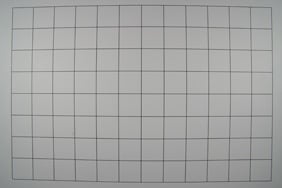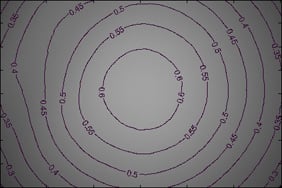Canon EF-S 10-22mm f/3.5-4.5 USM review
-
-
Written by Gordon Laing
Quality
Pictured below are the four zooms in Canon’s current EF-S range: from left to right the EF-S 10-22mm, EF-S 17-55mm, EF-S 17-85mm and EF-S 18-55mm lenses, each zoomed-out to their widest focal lengths.
Measuring 84x90mm (diameter x length), the EF-S 10-22mm is roughly as wide as the EF-S 17-55mm and tall as the EF-S 17-85mm, but unlike the other lenses pictured here, doesn’t physically extend as you zoom-in. Like the Canon EF 17-40mm, an internal section shifts back and forth slightly as you adjust the zoom, but does so entirely within the limits of the outer barrel. This makes the EF-S 10-22mm appear much smaller than the EF-S 17-85 and EF-S 17-55mm lenses when all are zoomed-in – see below.
With the same external barrel width as the EF-S 17-55mm, it’s not surprising to find the EF-S 10-22mm sharing the same 77mm filter thread. This is significantly larger than the 67mm thread of the EF-S 75-85mm or the 58mm of the EF-S 18-55mm lenses.
A lens hood (EW-83E) and carrying pouch (LP1319) are available for the EF-S 10-22mm, but you’ll need to buy them as optional extras. While this is the same situation as other EF-S lenses, it still seems a little mean not to at least include the lens hood. Pouches and hoods come as standard only with Canon’s L lenses.
The biggest physical difference between the four EF-S zooms is weight. At 385g, the EF-S 10-22mm may still be twice as heavy as the almost feather-like EF-S 18-55mm kit lens, but is noticeably lighter than the 475g EF-S 17-85mm and the relative heft of the 645g EF-S 17-55mm, although to be fair the latter does boast a constant f2.8 aperture.
The exterior design and build quality of the EF-S 10-22mm is to all intents and purposes identical to the EF-S 17-85mm and EF-S 17-55mm models. All have similar-feeling focusing and zoom rings, and position them with the focusing ring closest to the body and the zoom ring furthest. While all three lenses are a big step-up from the kit EF-S 18-55mm lens, none are in the same physical league as Canon’s L lenses. The zoom and focusing rings on L lenses feel much smoother and the overall build quality more confident.
In terms of focusing, the EF-S 10-22mm employs one of Canon’s USM motors which is both fast and quiet. It’ll focus from its closest 24cm distance to infinity in about half a second, and thanks to internal focusing, the filter mount doesn’t rotate – a relief for anyone who uses polarising or graduated filters.
To illustrate the range in practice we mounted an EOS 400D / XTi on a tripod and photographed the same scene with the EF-S 10-22mm at its shortest and longest focal lengths, then repeated the process a few moments later with the standard EF-S 18-55mm kit lens for comparison.
Canon EF-S 10-22mm f/3.5-4.5 USM | ||
 | 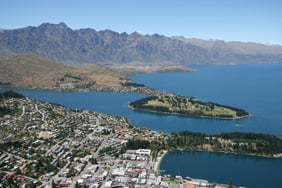 | |
| 10-22mm at 10mm, f8 (16mm equivalent) | 10-22mm at 22mm, f8 (35mm equivalent) | |
Above are the shots taken with the EF-S 10-22mm and below are those taken with the EF-S 18-55mm. Most obviously the EF-S 10-22mm captures an enormous field of view at 10mm, compared to the kit lens at its widest position, and there’s also some handy overlap at the longer end, with the EF-S 10-22mm zooming-in to a semi-wide focal length that could actually see it being used as a walk-around lens – albeit for wide-angle fanatics.
Canon EF-S 18-55mm f/3.5-5.6 | ||
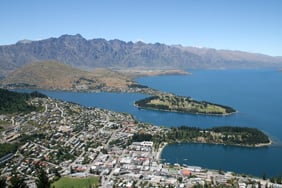 |  | |
| 18-55mm at 18mm, f8 (29mm equivalent) | 18-55mm at 55mm, f8 (88mm equivalent) | |
So what would you use such a wide angle lens for? Well as we’ll show in the Gallery on the next page, zooming-out to an equivalent focal length of 16mm allows you to capture massive views even at close range, which can be handy if you literally can’t step back any further. It’s equally useful for squeezing in large buildings at close range, or making interiors look bigger than they really are. Suffice it to say large group shots are never a problem.
Canon EF-S 10-22mm vs EF-S 18-55mm outdoor scene

The image left was taken with the Canon EOS-400D using the EF-S 10-22mm at 22mm f8; the original JPEG measured 4.2MB.
To compare real-life performance we shot the same scene with the EF-S 10-22mm and EF-S 18-55mm lenses within moments of each other using a Canon EOS-400D. Both lenses were tested here at 22mm f8, (equivalent to 35mm).The 400D was set to Large Fine JPEG mode and the Standard Picture Style. The crops are taken from the originals and presented here at 100%.
With both lenses set to 22mm f8 and focused at infinity, they deliver essentially the same degree of real-life detail in the middle of their fields, as illustrated in the centre crops. Note our resolution test on the next page though shows the EF-S 10-22mm slightly out-performing the kit lens in a studio environment.
The EF-S 10-22mm is clearly softer than the EF-S 18-55mm in the upper left corner as seen in the first row of crops, although roughly the same as the kit lens in the lower right corner as seen in the third row of crops.
It’s also interesting to compare the EF-S 10-22mm on the EOS 400D against the EF 17-40mm on a full-frame EOS 5D. In the results from our EF 17-40mm review, the lens performed very well when zoomed-out to wide angle, but once zoomed-into 40mm, our sample was very soft in the corners. So while the EF-S 10-22mm is a little softer than the EF-S 18-55mm in the corners, it’s not as bad as we experienced with the EF 17-40mm on a full-frame body. See our Gallery for more samples taken with the EF-S 10-22mm.
Canon EF-S 10-22mm f/3.5-4.5 USM resolution comparison with EOS 400D / XTi
Canon EF-S 10-22mm f/3.5-4.5 USM | Canon EF-S 18-55mm f/3.5-5.6 | |
 | 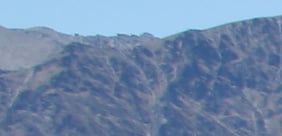 | |
1/250, f8, 100 ISO | 1/250, f8, 100 ISO | |
 |  | |
1/250, f8, 100 ISO | 1/250, f8, 100 ISO | |
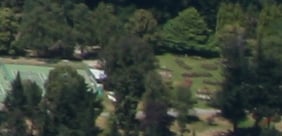 | 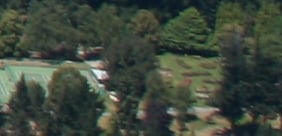 | |
1/250, f8, 100 ISO | 1/250, f8, 100 ISO |
To measure and compare the resolving power of the EF-S 10-22mm, we photographed the Enhanced Digital Camera Resolution Chart using it and a number of rival lenses mounted on a Canon EOS 400D. The 10-22mm was tested at a focal length of 22mm and the other three lenses at 35mm; all were set to f8 in Aperture Priority mode. The 400D was set to Large Fine JPEG mode and its Standard Picture Style.
The crops are taken from the original images, saved as High Quality JPEGs in Photoshop CS2 and presented here at 100%. Each number represents 100 lines per picture height (lpph), so a figure of 20 means a resolution of 2000 lpph.
In terms of horizontal resolution, the EF-S 10-22mm performs well, delivering 2100 lpph. This is slightly better than both the EF-S 17-85mm and EF-S 18-55mm lenses, although not quite as good as the EF-S 17-55mm.
Canon EF-S 10-22mm results continued…In terms of vertical resolution, the EF-S 10-22mm again delivered 2100 lpph, this time matching the EF-S 17-85mm and EF-S 18-55mm lenses. Again though the EF-S 17-55mm takes a slight lead. So while the EF-S 17-55mm remains the resolution leader of the EF-S zooms, the EF-S 10-22mm certainly has nothing to be ashamed of. It matches or slightly out-performs all but the EF-S 17-55mm in this particular test. Note the EF-S 10-22mm was tested at 22mm, while the other three were tested at 35mm.
Canon EF-S 10-22mm f/3.5-4.5 | Canon EF-S 17-85mm f/4-5.6 IS USM | |
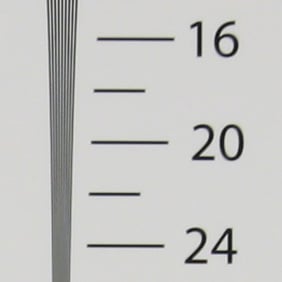 |  | |
2100 lpph, 10-22mm at 22mm, f8, 100 ISO | 2150 lpph, 17-85mm at 35mm, f8, 100 ISO | |
Canon EF-S 18-55mm f/3.5-5.6 | Canon EF-S 17-55mm f/2.8 IS USM | |
 |  | |
2000 lpph, 18-55mm at 35mm, f8, 100 ISO | 2050 lpph, 17-55mm at 35mm, f8, 100 ISO |
Canon EF-S 10-22mm f/3.5-4.5 | Canon EF-S 17-85mm f/4-5.6 IS USM | |
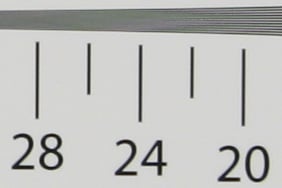 |  | |
2100 lpph, 10-22mm at 22mm, f8, 100 ISO | 2150 lpph, 17-85mm at 35mm, f8, 100 ISO | |
Canon EF-S 18-55mm f/3.5-5.6 | Canon EF-S 17-55mm f/2.8 IS USM | |
 |  | |
2100 lpph, 18-55mm at 35mm, f8, 100 ISO | 2100 lpph, 17-55mm at 35mm, f8, 100 ISO |
Canon EF-S 10-22mm corner sharpness comparison
To measure and compare the Canon 10-22mm’s corner sharpness we photographed the Enhanced Digital Camera Resolution Chart with it and a number of lenses using a Canon EOS-400D. The 400D was set to Large Fine JPEG mode and its Standard Picture Style.
Each lens was tested at its widest and longest focal lengths and with various apertures using Aperture Priority mode. The crops are taken from the lower left corner of the chart and presented here at 100%. No crops have been resized.
Zoomed-out to 10mm with its aperture wide open, the EF-S 10-22mm lens suffers from softness in the extreme corners, but it’s greatly improved as the aperture’s closed. It’s interestingly quite similar to the EF-S 18-55mm in this particular test, although the premium EF-S 17-55mm continues to deliver the best result, impressively even when its aperture is wide open at f2.8.
Canon EF-S 10-22mm f/3.5-4.5 USM | Canon EF-S 17-85mm f/4-5.6 IS USM | Canon EF-S 18-55mm f/3.5-5.6 | Canon EF-S 17-55mm f/2.8 IS USM | |||
 |  |  | 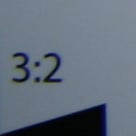 | |||
f2.8 not available | f2.8 not available | f2.8 not available | 17-55mm EF-S at 17mm f2.8 | |||
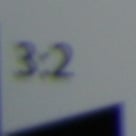 | 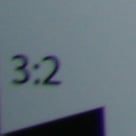 | 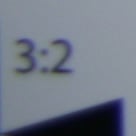 | 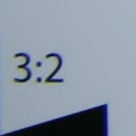 | |||
10-22mm EF-S at 10mm f3.5 | 17-85mm EF-S at 17mm f4 | 18-55mm EF-S at 18mm f3.5 | 17-55mm EF-S at 17mm f4 | |||
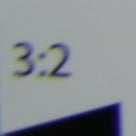 | 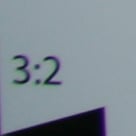 | 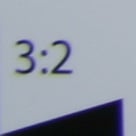 | 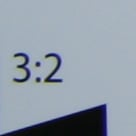 | |||
10-22mm EF-S at 10mm f8 | 17-85mm EF-S at 17mm f8 | 18-55mm EF-S at 18mm f8 | 17-55mm EF-S at 17mm f8 | |||
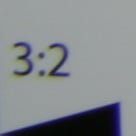 | 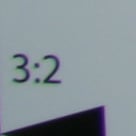 | 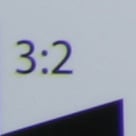 | 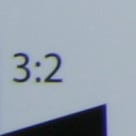 | |||
10-22mm EF-S at 10mm f16 | 17-85mm EF-S at 17mm f16 | 18-55mm EF-S at 18mm at f16 | 17-55mm EF-S at 17mm f16 | |||
Canon EF-S 10-22mm f/3.5-4.5 USM | Canon EF-S 17-85mm f/4-5.6 IS USM | Canon EF-S 18-55mm f/3.5-5.6 | Canon EF-S 17-55mm f/2.8 IS USM | |||
 |  |  | 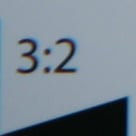 | |||
f2.8 not available | f2.8 not available | f2.8 not available | 17-55mm EF-S at 55mm f2.8 | |||
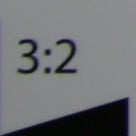 | 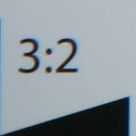 | 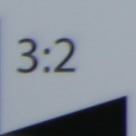 | 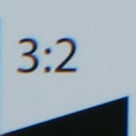 | |||
10-22mm EF-S at 22mm f4.5 | 17-85mm EF-S at 85mm f5.6 | 18-55mm EF-S at 55mm f5-6 | 17-55mm EF-S at 55mm f5.6 | |||
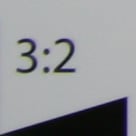 | 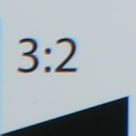 | 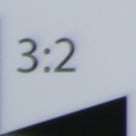 | 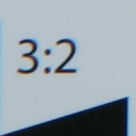 | |||
10-22mm EF-S at 22mm f8 | 17-85mm EF-S at 85mm f8 | 18-55mm EF-S at 55mm f8 | 17-55mm EF-S at 55mm f8 | |||
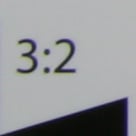 | 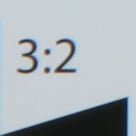 | 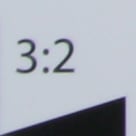 | 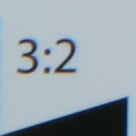 | |||
10-22mm EF-S at 22mm f16 | 17-85mm EF-S at 85mm f16 | 18-55mm EF-S at 55mm f16 | 17-55mm EF-S at 55mm f16 |
Zoomed-into 22mm, the EF-S 10-22mm delivers good results here throughout its aperture range which are roughly equivalent to the EF-S 17-85mm and EF-S 17-55mm when all are zoomed-in. Of course when the EF-S 10-22mm is zoomed-in, the focal length is closer to the other lenses zoomed-out. Therefore it’s well worth comparing the second set of results from the EF-S 10-22mm with the first set of results from the other three. Clearly the EF-S 10-22mm performs well in this regard, especially compared against the EF-S 17-85mm and EF-S 18-55mm models at similar focal lengths.
Canon EF-S 10-22mm purple fringe and macro comparison
We tested each lens at its widest and longest focal lengths with the aperture wide open using a Canon EOS-400D in Aperture Priority mode. The crops are taken from the upper left corner of the chart and presented here at 100%.To measure and compare the Canon 10-22mm’s purple fringing caused by lens chromatic aberrations and sensor blooming, we photographed a test chart with areas of very high contrast using it and a number of rival lenses.
The Canon EF-S 10-22mm exhibits a little purple fringing at its widest position in line with the others. Fringing is virtually absent at the long end, again in line with the other three.
Canon EF-S 10-22mm f/3.5-4.5 USM | Canon EF-S 17-85mm f/4-5.6 IS USM | Canon EF-S 18-55mm f/3.5-5.6 | Canon EF-S 17-55mm f/2.8 IS USM | |||
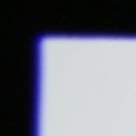 | 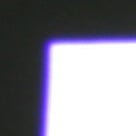 | 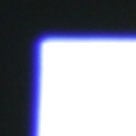 | 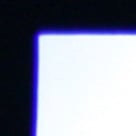 | |||
10-22mm EF-S at 10mm f3.5 | 17-85mm EF-S at 17mm f4.0 | 18-55mm EF-S at 18mm f3.5 | 17-55mm EF-S at 17mm f2.8 | |||
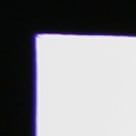 | 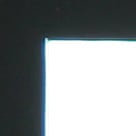 | 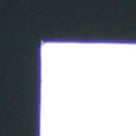 | 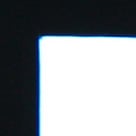 | |||
10-22mm EF-S at 22mm f4.5 | 17-85mm EF-S at 85mm f5.6 | 18-55mm EF-S at 55mm f5.6 | 17-55mm EF-S at 55mm f2.8 |
Canon EF-S 10-22mm f/3.5-4.5 USM macro comparison
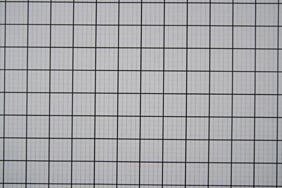 |
| 10-22mm EF-S at 22mm f8 (35mm equiv) Max area of 124x82mm |
The dark lines are 10mm apart and the result is not cropped. Smaller areas are preferred in this test.To measure and compare the Canon 10-22mm’s macro performance we photographed a chart using it and a number of rival lenses at a focal length and distance which delivered the maximum possible reproduction.
The image above was taken with the Canon EF-S 10-22mm zoomed-into 22mm f8. With the lens positioned at its closest focusing distance, it delivered an area measuring 124x82mm, coincidentally identical to our measurement taken with the EF-S 17-55mm. Geometric distortion, as detailed on the next page, is respectably low, but the relatively large area won’t get any macro enthusiasts excited. To be fair though, the EF-S 10-22mm isn’t designed to produce large reproductions. It is possible though to get pretty close to a subject while maintaining a large depth of field, as illustrated in our Gallery. The macro result here is also significantly better than the 166x110mm area captured by the EF 17-40mm on a full-frame Canon EOS 5D.
Canon EF-S 17-85mm f/4-5.6 IS USM | Canon EF-S 18-55mm f/3.5-5.6 | Canon EF-S 17-55mm f/2.8 IS USM | ||
 | 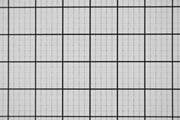 | 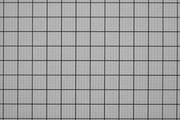 | ||
| 17-85mm EF-S at 85mm f8 Max area of 104x70mm | 18-55mm EF-S at 55mm f8 Max area of 66x44mm | 17-55mm EF-S at 55mm f8 Max area of 124x82mm |
Canon EF-S 10-22mm geometry comparison
| To measure and compare the Canon 10-22mm’s geometric distortion we photographed a test chart consisting of a grid pattern, using it and a number of rival lenses.The lenses were tested at their widest focal lengths with an aperture of f8 using a Canon EOS-400D in Aperture Priority mode.The images were analysed with Imatest using 5th Order line calculation and the full areas presented here at a reduced resolution. |
The image above was taken with the Canon EF-S 10-22mm at 10mm f8. Barrel distortion was measured at 3.59% which is remarkably low considering the extreme wide angle coverage at this focal length. It’s roughly comparable to the distortion you’ll experience with the EF-S 18-55mm when it’s zoomed-out, and a significant improvement over the EF-S 17-85mm at 17mm. It’s also worth comparing against the EF 17-40mm tested on a full frame body, which delivers coverage almost as wide (17mm actual versus 16mm equivalent). In our EF 17-40mm review, geometric distortion at 17mm on an EOS 5D was measured at 6.39% – considerably higher. An impressive result here for the EF-S 10-22mm.
Canon EF-S 17-85mm f/4-5.6 IS USM | Canon EF-S 18-55mm f/3.5-5.6 | Canon EF-S 17-55mm f/2.8 IS USM | ||
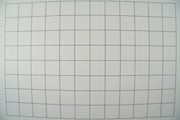 | 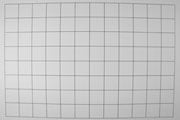 | 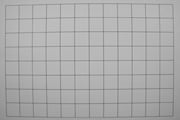 | ||
| 17-85mm EF-S at 17mm f8 Distortion: 5.71% barrel | 18-55mm EF-S at 18mm f8 Distortion: 3.35% barrel | 17-55mm EF-S at 17mm f8 Distortion: 2.87% barrel |
Canon EF-S 10-22mm f/3.5-4.5 USM geometry comparison (longest focal length)
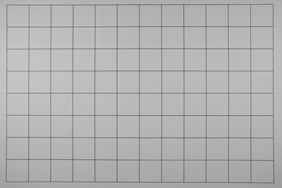 |
| 10-22mm EF-S at 22mm f8 (35mm equiv) Distortion: 0.24% barrel |
The lenses were tested at their longest focal lengths with an aperture of f8 using a Canon EOS-400D in Aperture Priority mode.To measure and compare the Canon 10-22mm’s geometric distortion we photographed a test chart consisting of a grid pattern, using it and a number of rival lenses.
The images were analysed with Imatest using 5th Order line calculation and the full areas presented here at a reduced resolution.
The image above was taken with the Canon EF-S 10-22mm at 22mm f8. While most lenses exhibit pincushion distortion when zoomed-in, the EF-S 10-22mm showed barrelling. This however isn’t that surprising considering the lens is still quite wide even when zoomed-in, and more importantly the actual degree of distortion at just 0.24% is very low. Judging from this and the above result, the EF-S 10-22mm is a good performer when it comes to geometric distortion, which will come as a relief to anyone shooting buildings indoors or out.
Canon EF-S 10-22mm f/3.5-4.5 USM uniformity comparison (shortest focal length)
Canon EF-S 17-85mm f/4-5.6 IS USM | Canon EF-S 18-55mm f/3.5-5.6 | Canon EF-S 17-55mm f/2.8 IS USM | ||
 | 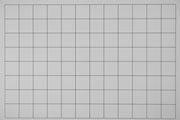 | 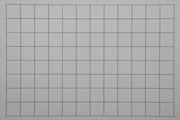 | ||
| 17-85mm EF-S at 85mm f8 Distortion: 0.967% pincushion | 18-55mm EF-S at 55mm f8 Distortion: 0.389% pincushion | 17-55mm EF-S at 55mm f8 Distortion: 1.09% pincushion |
Canon EF-S 10-22mm uniformity comparison
| |||
To measure and compare the Canon 10-22mm’s vignetting and light fall-off we photographed a white target with a highly diffused custom filter using it and a number of rival lenses.
The lenses were tested at their widest focal lengths with the aperture wide open using a Canon EOS-400D in Aperture Priority mode.
The images were analysed with Imatest and the full areas presented here at a reduced resolution. Bigger percentages are better.
The image left was taken with the Canon EF-S 10-22mm lens at 10mm f3.5. Here the light falls off in the corners to an average of 42.3% of the center measurement, which while noticeably worse than the kit and EF-S 17-85mm lenses, is not unexpected for such an extreme wide angle lens. Indeed it’s worth comparing how a lens with similar wide angle coverage performs on a full frame body: in our EF 17-40mm review using a Canon EOS 5D, the light fell off in the corners to 34.3% of the center measurement. It’s also worth pointing out that while the corner light fall-off value of the EF-S 10-22mm is similar to the EF-S 17-55mm, the latter suffers from a much steeper and more noticeable gradient in the far corners, whereas the former is more gentle and less obvious. So not a bad result for the EF-S 10-22mm here considering its extreme coverage.
Canon EF-S 17-85mm f/4-5.6 IS USM | Canon EF-S 18-55mm f/3.5-5.6 | Canon EF-S 17-55mm f/2.8 IS USM | ||
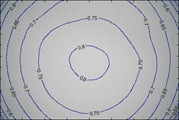 | 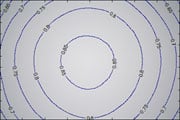 | 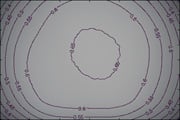 | ||
| 17-85mm EF-S at 17mm f4 Mean corner fall-off: 57.8% | 18-55mm EF-S at 18mm f3.5 Mean corner fall-off: 68.8% | 17-55mm EF-S at 17mm f2.8 Mean corner fall-off: 46.8% |
Canon EF-S 10-22mm f/3.5-4.5 USM uniformity comparison (longest focal length)
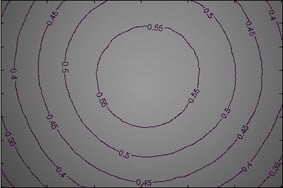 |
| 10-22mm EF-S at 22mm f4.5 (35mm equiv) Mean corner fall-off: 55.3% |
The lenses were tested at their longest focal lengths with the aperture wide open using a Canon EOS-400D in Aperture Priority mode.To measure and compare the Canon 10-22mm’s vignetting and light fall-off we photographed a white target with a highly diffused custom filter using it and a number of rival lenses.
The images were analysed with Imatest and the full areas presented here at a reduced resolution. Bigger percentages are better.
The image above was taken with the Canon EF-S 10-22mm lens at 22mm f4.5. Here the light falls off in the corners to an average of 55.3% of the center measurement, which again is worse then the kit and EF-S 17-85mm lenses, but not too far behind the EF-S 17-55mm. Once again the gradient is quite gentle and not particularly noticeable in real-life. Interestingly the light fall-off measured for the EF 17-40mm on the full-frame Canon EOS 5D is better than the EF-S 10-22mm when both are zoomed-in. At 40mm it measured a fairly respectable 63.1%.
Canon EF-S 17-85mm f/4-5.6 IS USM | Canon EF-S 18-55mm f/3.5-5.6 | Canon EF-S 17-55mm f/2.8 IS USM | ||
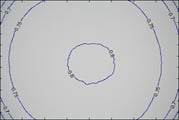 | 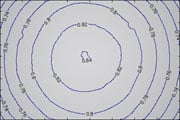 | 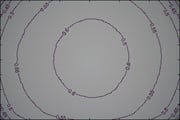 | ||
| 17-85mm EF-S at 85mm f5.6 Mean corner fall-off: 77.5% | 18-55mm EF-S at 55mm f5.6 Mean corner fall-off: 83.8% | 17-55mm EF-S at 55mm f2.8 Mean corner fall-off: 60.8% |
